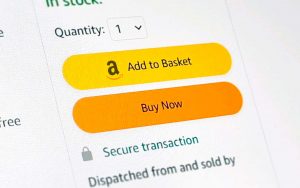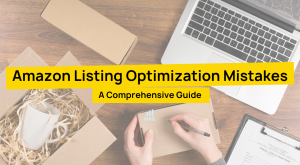Torn between Amazon Seller Central and Vendor Central? Why not master both and watch your business soar?
Amazon sellers often feel stuck between choosing Seller Central or Vendor Central as their primary platform. Both offer different advantages, but it’s hard to know which one will really maximize profits and control.
Seller Central gives you more control but requires constant hands-on management, while Vendor Central offers bulk orders but limits your control. Choosing the wrong model could leave you with lower profits and fewer options.
Here’s a bold idea—don’t choose. With a hybrid selling model, you can leverage both Amazon Seller Central and Vendor Central to combine the best of both worlds.
As an Amazon agency dedicated to helping businesses thrive on the platform, we’ve crafted this guide to help you understand and maximize the hybrid selling strategy. Let’s dive into how you can achieve maximum profit and flexibility by using both approaches effectively.
What Is Amazon Seller Central?
Amazon Seller Central is a platform that allows third-party sellers to manage and grow their business on Amazon. It acts as the central hub where sellers list products, manage pricing, fulfill orders, and track performance.
Seller Central is accessible to any business owner or entrepreneur looking to sell directly to consumers on Amazon. In this platform:
- Sellers on Amazon are effectively retailers.
- They manage their own inventory, customer service, and pricing.
- They control their own product listings and content.
- • They have direct contact with end consumers.
What Does Seller Central Offer?
Seller Central provides a wide range of tools to help sellers optimize their operations, including:
- Listing Products: Add products directly or via bulk uploads.
- Inventory Management: Track, adjust, and manage your stock.
- Order Fulfillment: Manage orders yourself or send inventory to Amazon’s fulfillment network (FBA).
- Customer Service: Handle returns, monitor reviews, and manage feedback.
- Promotions: Offer deals, discounts, and coupons.
- Analytics: Track visits, sales, and performance metrics.
- Account Health: Monitor customer service, shipping, and compliance.
Key Takeaways from the video:
- The Amazon Seller Central dashboard is a comprehensive tool for managing your Amazon business.
- Understanding the dashboard’s features is crucial for effective use.
Understanding Vendor Central
Amazon Vendor Central is an invite-only platform where businesses sell products directly to Amazon at wholesale prices. Amazon then takes care of everything—inventory management, shipping, pricing, and customer service.
Unlike Seller Central, where sellers manage their own listings and sell directly to consumers, Vendor Central shifts the entire process to Amazon.
What Does Vendor Central Offer?
Having a Vendor Central account provides sellers with several benefits, including:
- Bulk Selling: Sell large quantities of products to Amazon, which then handles distribution.
- No Direct Buyer Interaction: Amazon manages customer service, eliminating the need for seller engagement with buyers.
- Wide Distribution: Leverage Amazon’s expansive fulfillment network to reach more customers.
- Cost Reduction: Amazon handles warehousing, shipping, and logistics, reducing overhead costs for sellers.
Key Takeaways from the video:
- The item maintenance form is a tool for making changes to product listings in Vendor Central.
- To use it, download the form, fill it out, and submit it as an attachment to a support ticket.
Benefits of Vendor Central
- Reduced Operational Responsibility: Amazon takes care of everything, from shipping to customer interactions.
- Access to a Larger Customer Base: When you become a vendor, you can benefit from Amazon’s vast distribution channels.
- Simplified Business Model: Focus on production and wholesale, while Amazon manages the retail aspect.
Challenges of Vendor Central
- Less Control: Amazon controls pricing, product display, and promotions, leaving sellers with limited say.
- Unpredictable Demand: Orders from Amazon can be irregular, making inventory management more challenging.
- Restricted Access: Vendor Central is invite-only, making it difficult to join without an Amazon invitation.
When to Use Vendor Central
- Large Brands & Manufacturers: Ideal for established brands and manufacturers capable of handling large orders and high-volume production. Vendor Central is well-suited for well-known consumer brands and large-scale distributors.
- Increased Visibility & Credibility: Provides enhanced exposure and credibility by featuring products with Amazon’s extensive customer base, boosting brand recognition.
- Bulk Selling: Facilitates the sale of large quantities directly to Amazon, which manages logistics and retail, benefiting wholesalers by simplifying inventory distribution.
- Enhanced Shopper Confidence: Products are labeled as “Shipped and Sold by Amazon,” increasing consumer trust in product authenticity and quality.
- Additional Advertising Opportunities: Offers increased advertising options and streamlined management, which are advantageous in a hybrid selling on Amazon strategy.
When to Consider Seller Central or a Hybrid Strategy
- Pricing Control: If you prefer setting and adjusting your own prices, Seller Central may be better as Vendor Central offers little pricing flexibility.
- Direct Customer Engagement: Seller Central allows for a more hands-on approach to managing customer relationships, reviews, and feedback.
- Hybrid Approach: Some businesses use a combination of both platforms—Vendor Central for bulk items and Seller Central for niche or premium products—balancing control with Amazon’s logistics power.
Tips On Getting Vendor Central Invitation
Since Vendor Central is an invite-only platform, here are some actionable strategies to increase your chances of receiving an invitation.
Vendor Requirements
- Supplier/Manufacturer Relevance: Ensure your business is a respected supplier or brand. Amazon typically invites manufacturers or authorized distributors.
- Sales Performance: Showcase strong sales performance to enhance your chances of receiving an invitation.
- Operational Capabilities: Demonstrate your ability to handle wholesale orders and meet Amazon’s fulfillment requirements.
- Marketplace Appeal: Offer products with high demand or innovative items that stand out in the Amazon marketplace.
Product Eligibility
- Product Category: Aim for categories with high demand or strategic interest from Amazon.
- Competitive Wholesale Pricing: Ensure your products are competitively priced to attract Amazon’s interest.
- Product Quality and Safety: Comply with safety standards and regulations to meet Amazon’s criteria.
Requesting an Invitation
- Direct Application Process: Visit Amazon’s official Vendor Central website for application options. Submit an inquiry with detailed information about your business and why your products are a good fit. Ensure your communication is professional and comprehensive.
- Networking and Visibility: Increase brand visibility by attending trade shows and industry events where Amazon representatives might be present. Prepare a strong pitch highlighting your brand’s unique value proposition and alignment with Amazon’s customer base. Engage actively in industry forums and social media to gain attention.
Why Amazon Hybrid Selling Strategy?
The Amazon Hybrid Selling Strategy allows businesses to operate as both a vendor and a seller. As a vendor, you sell products in bulk to Amazon, which manages logistics, pricing, and customer service.
As a professional seller, you retain control over inventory, pricing, and have direct contact with customers. This dual approach combines the benefits of both Amazon Vendor Central and Seller Central.
Benefits of a Hybrid Strategy
- Product Availability: If Amazon does not reorder through Vendor Central, you can continue selling through your seller account, preventing stockouts.
- Pricing Control: Sellers have flexibility to adjust pricing, while Vendor Central pricing is controlled by Amazon.
- Faster Listings: Sellers can list products quicker than vendors, making items available immediately.
- Data Access: Seller accounts provide more detailed sales data, helping improve business decisions.
- Logistics Flexibility: Items Amazon deems unprofitable or problematic can still be sold via your seller account.
Challenges to Consider
- Higher Workload: Managing both Vendor and Seller Central requires significant effort, particularly around inventory, customer service, and fulfillment.
- Customer Satisfaction: As a seller, you are responsible for meeting Amazon’s high standards for customer service, which can impact performance ratings.
- Country-specific Laws: Sellers must navigate legal requirements in different countries, unlike Vendor Central where Amazon handles these issues.
- Competition with Wholesalers: Selling directly may put you in competition with your wholesale partners, which can create internal conflicts.
Is The Hybrid Approach Right For You?
Combining Amazon Vendor Central and Amazon Seller Central can create a robust selling strategy, but it’s important to evaluate if this approach fits your business. Here’s what you need to consider to determine if the hybrid model is suitable for you and what you need to get started:
Assess Your Goals
The hybrid model allows you to sell both directly to Amazon (Vendor Central) and to customers (Seller Central), increasing your product visibility and market reach.
Evaluate Your Resources
Managing both platforms requires significant time and effort. Ensure you have a dedicated team to handle the additional responsibilities.
Examine Your Products
Popular, high-volume products are ideal for Vendor Central, as Amazon buys in bulk. Unique or niche products perform better on Seller Central, where you control pricing and promotions.
Understand the Financial Implications
Vendor Central provides steady income with large orders but generally lower margins. Seller Central offers higher profits but demands more effort and management.
Prepare for Platform Management
Each platform has its own tools and terms. Be ready for the learning curve and additional liabilities. Seller Central requires more in-depth management of inventory and reporting.
Commit to Time Management
Selling through Seller Central involves managing your inventory, forecasts, and customer service. Allocate time or resources to handle these tasks effectively.
Handle Sales Tax Collection
Selling on Seller Central means you must manage sales tax collection and remittance. Consult with an accountant to understand your obligations under the hybrid model.
Challenges to Expect
- Increased Complexity: Balancing two platforms can be complex, requiring careful coordination of inventory, pricing, and marketing.
- Additional Responsibilities: You’ll need to manage customer service, handle sales tax, and adapt to different platform requirements.
Are you considering using the Hybrid Selling Model? Here is a short quiz you can take to help determine if it is the right approach for you.
Maximizing the Hybrid Selling Model on Amazon
Combining Amazon Seller Central and Vendor Central offers a powerful strategy for boosting sales. By selling directly to Amazon through Vendor Central and reaching customers via Seller Central, brands can leverage diverse selling opportunities.
Effective strategies can help optimize, manage, and track performance across both platforms, making the hybrid approach a valuable, though complex, method for enhancing your Amazon sales.
Product Diversification
- Leverage Vendor Central for high-demand, popular products
Benefit from Amazon’s efficient order fulfillment and shipping capabilities, especially for large orders.
- Utilize Seller Central for niche or customized products
Maintain greater control over pricing, customer interactions, and product customization options.
Market Reach
- Expand your reach with Vendor Central
Benefit from Amazon’s extensive customer base and distribution channels, including Prime.
- Target specific audiences with Seller Central
Utilize targeted advertising, promotions, and direct customer interactions to reach your ideal customers.
Brand Management
- Maintain brand consistency with Vendor Central
Benefit from Amazon’s branding tools and guidelines to ensure a cohesive brand experience.
- Gain valuable insights with Seller Central
Gather customer feedback, analyze sales data, and experiment with different marketing strategies to refine your brand and offerings.
Product Launches
- Leverage Vendor Central for initial exposure
Utilize Vendor Central to showcase your new product to Amazon’s vast customer base.
- Drive initial sales with Seller Central
Create a compelling listing on Seller Central and utilize marketing features to generate initial sales and build sales history.
- Utilize Amazon’s hybrid model
Benefit from the synergy between the two platforms by listing your product on both to overcome the initial sales hurdle.
Price Management
- Leverage price competition
Utilize Seller Central to strategically adjust your pricing to compete with Amazon for the buy box.
- Reverse the feedback loop
By strategically lowering your price on Seller Central, you can force Amazon to lower their price, potentially leading to increased conversions, relevancy, and search visibility.
- Monitor and adjust
Continuously monitor Amazon’s pricing and adjust your own as needed to maintain a competitive advantage.
Inventory Management
- Address inventory inaccuracies
Utilize the hybrid model to supplement Vendor Central inventory with Seller Central listings, mitigating the risk of stockouts due to Amazon’s potential forecasting errors.
- Ensure continuous availability
By maintaining inventory on both platforms, you can ensure that your products remain available to customers even during periods of high demand or supply chain disruptions.
Listing Optimization
- Supplement missing data
Utilize Seller Central to track listing traffic and conversion rates, which are not available in Vendor Central.
- Analyze and optimize
Use this data to split test different elements of your listings, such as images, titles, and product details, to identify the most effective combinations.
- Drive long-term growth
By continuously optimizing your listings, you can improve your search visibility, increase conversion rates, and drive sustainable growth on Amazon.
Managing Two Platforms Without Losing Your Mind
The Amazon Hybrid Selling Strategy combines the roles of both vendor and seller, offering flexibility and control but also introducing complexities. Managing this model can be demanding, but with the help of an Amazon agency like My Amazon Guy, you can navigate these challenges effectively.
How My Amazon Guy Simplifies Hybrid Selling
Implementing a hybrid selling strategy on Amazon can be challenging, given the intricacies of both Seller Central and Vendor Central. Our services are designed to guide you through this process and maximize your success.
Successful Account Setups
Our Amazon experts ensure your business is set up to manage both platforms effectively. We help you meet Amazon’s requirements and maximize sales by optimizing your accounts with data-driven insights.
Product Assortment and Management
- Assortment Guidance: We assess your product range and recommend the best way to divide it between Seller Central and Vendor Central.
- Scalability Support: Whether expanding your product line or refining your current offerings, we help you build the right assortment for hybrid success.
- Tailored Solutions: No one-size-fits-all approach—we customize strategies based on your brand’s setup, capabilities, and product variety.
Product Life Cycle Management
At My Amazon Guy, we guide businesses on how to leverage Seller Central and Vendor Central effectively throughout the product life cycle.
- New Product Launches: We help you use Seller Central to launch new products, allowing full control over pricing, higher margins, and targeted marketing.
- Product Awareness: By managing retail pricing and customer reviews, we ensure your new products receive the attention and nurturing they need to succeed.
- Strategic Shifts: As products mature, we assist in transitioning between Seller Central and Vendor Central for optimal long-term growth.
Retail Pricing
At My Amazon Guy, we help businesses navigate pricing challenges in a hybrid model, ensuring profitability and customer satisfaction.
- Tackling Low Price Items: We recommend multi-pack offerings for low-priced items on Vendor Central to increase basket spend and cover shipping costs.
- Flexible Sales Models: For single items, we guide brands to use Seller Central when Vendor Central margins are tight, ensuring more control over pricing.
- Testing Multi-Packs: We assist in trialing multi-packs on Seller Central, offering scalability once sales velocity is proven.
Continuity and Seasonal Products Management
- Vendor for Continuity Items: We recommend offering Amazon’s Vendor Central continuity products with steady availability and proven sales history to ensure consistent orders.
- Seller Central for Seasonal Products: For seasonal items, we guide brands to use Seller Central, allowing them to manage pricing, inventory sell-through, and avoid premature price drops.
- Strategic Sell-Through: We help brands maintain control over discounting seasonal items at the right time to clear inventory while protecting margins.
Selling Core and Non-core Items
- Vendor for Core Products: We recommend offering top sellers with steady demand and strong availability via Vendor Central for consistent volume orders and favorable pricing.
- Seller Central for Non-Core Items: Slower sellers or items with tighter margins are better suited for Seller Central, allowing brands to control inventory, pricing, and run tests to boost sales.
- Tailored Solutions for Variants: We help brands offer popular product variants through Vendor Central while managing lower-demand options on Seller Central to optimize profitability and availability.
Selling Primary Products and Accessories
- Vendor for Core Products: We recommend using Vendor Central for primary products like refrigerators, leveraging Amazon’s Fulfillment Centers for efficient storage and distribution.
- Seller Central for Accessories: For slower-selling parts and accessories, we suggest utilizing Seller Central to manage inventory and pricing directly, ensuring availability and customer communication.
- Hybrid Approach: Alternatively, brands can combine both methods by offering core products through Vendor Central and handling parts and accessories via Direct Fulfillment, balancing inventory control with streamlined order processing.
Additional Services to Boost Your Amazon Sales
- Optimize Your Listings: We improve titles, descriptions, A+ content, and images to enhance SEO and customer satisfaction, ensuring consistency across all channels.
- Increase Advertising Efforts: Our data-driven approach to Amazon Advertising helps you maintain visibility, build brand authority, and outpace competitors in search results.
- Enforce Brand Protection: We help remove unauthorized sellers and enforce MAP policies, protecting your brand and increasing your chances of reclaiming the Buy Box.
We Help Businesses Thrive With Amazon Seller Central, Vendor Central, Or Hybrid Selling
The Amazon hybrid model offers a powerful way to expand your reach and enhance profitability. Balancing both Vendor Central and Seller Central can be complex, but the rewards are substantial.
Ready to leverage the best of both worlds? Contact our Full Service Amazon Agency to expertly manage your Seller Central, Vendor Central, or hybrid strategy. Let us handle the details so you can focus on growing your business.






